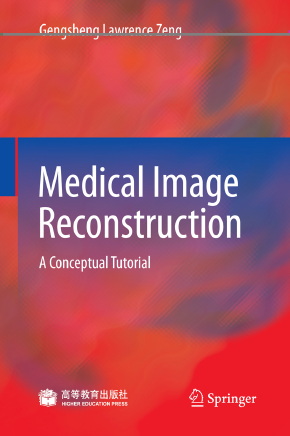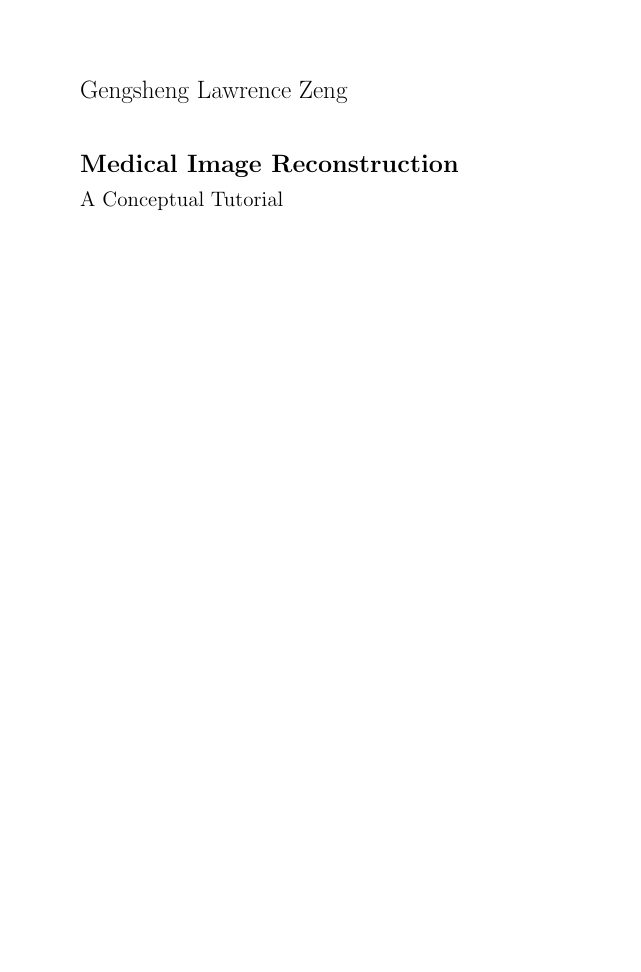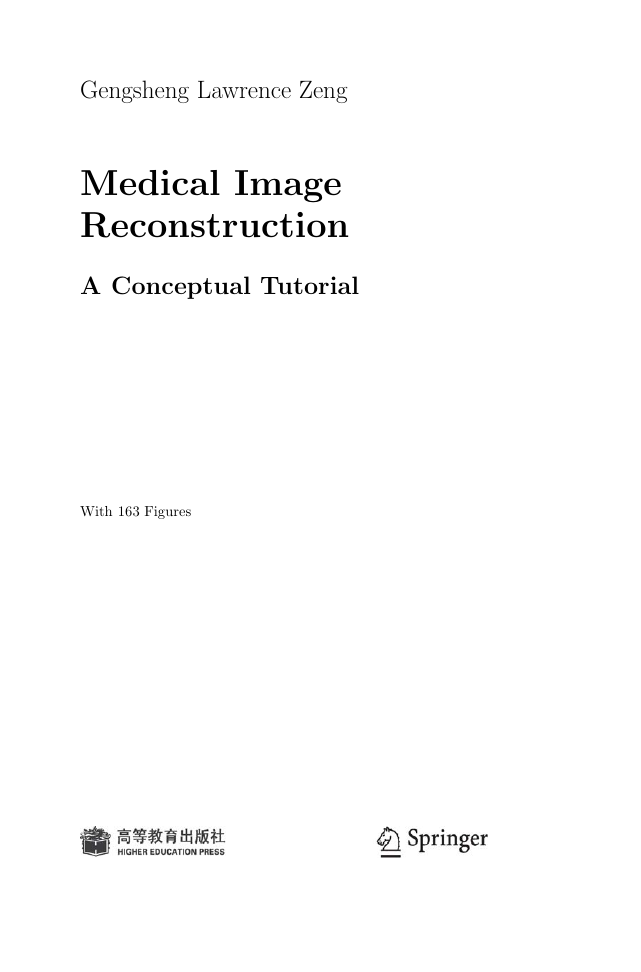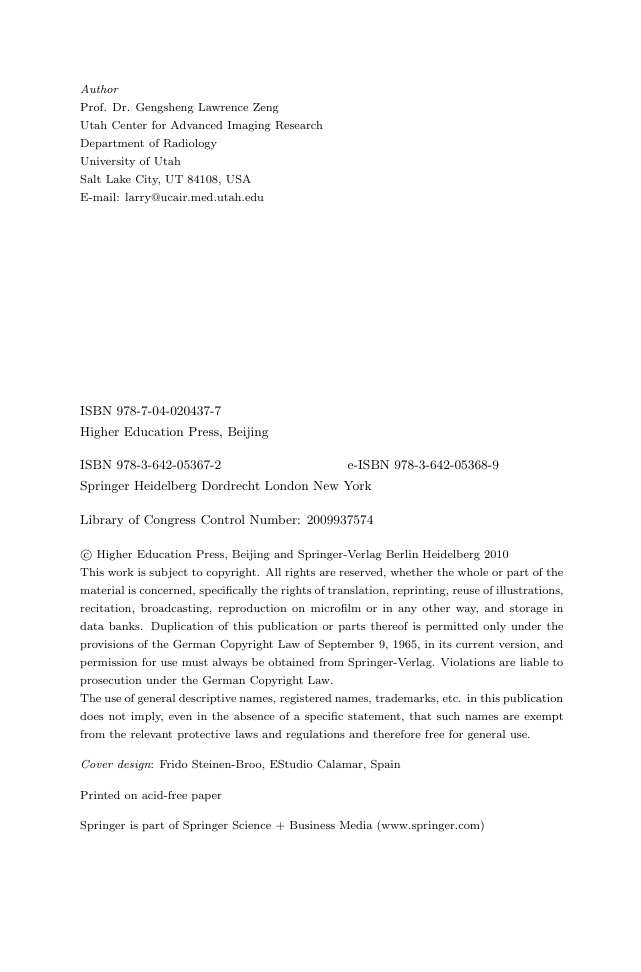Medical Image Reconstruction: A Conceptual Tutorial
Front-matter
Title Page
Copyright Page
Preface
Table of Contens
1 Basic Principles of Tomography
1.1 Tomography
1.2 Projection
1.3 Image Reconstruction
1.4 Backprojection
∗1.5 Mathematical Expressions
1.5.1 Projection
1.5.2 Backprojection
1.5.3 The Dirac δ-function
1.6 Worked Examples
1.7 Summary
Problems
References
2 Parallel-Beam Image Reconstruction
2.1 Fourier Transform
2.2 Central Slice Theorem
2.3 Reconstruction Algorithms
2.3.1 Method 1
2.3.2 Method 2
2.3.3 Method 3
2.3.4 Method 4
2.3.5 Method 5
2.4 A Computer Simulation
∗2.5 ROI Reconstruction with Truncated Projections
∗2.6 Mathematical Expressions
2.6.1 The Fourier Transform and Convolution
2.6.2 The Hilbert Transform and the Finite Hilbert Transform
2.6.3 Proof of the Central Slice Theorem
2.6.4 Derivation of the Filtered Backprojection Algorithm
2.6.5 Expression of the Convolution Backprojection Algorithm
2.6.6 Expression of the Radon Inversion Formula
2.6.7 Derivation of the Backprojection-then-Filtering Algorithm
2.7 Worked Examples
2.8 Summary
Problems
References
3 Fan-Beam Image Reconstruction
3.1 Fan-Beam Geometry and Point Spread Function
3.2 Parallel-Beam to Fan-Beam Algorithm Conversion
3.3 Short Scan
∗3.4 Mathematical Expressions
3.4.1 Derivation of a Filtered Backprojection Fan-Beam Algorithm
3.4.2 A Fan-Beam Algorithm Using the Derivative and the Hilbert Transform
3.5 Worked Examples
3.6 Summary
Problems
References
4 Transmission and Emission Tomography
4.1 X-Ray Computed Tomography
4.2 Positron Emission Tomography and Single Photon Emission Computed Tomography
4.3 Attenuation Correction for Emission Tomography
∗4.4 Mathematical Expressions
4.5 Worked Examples
4.6 Summary
Problems
References
5 3D Image Reconstruction
5.1 Parallel Line-Integral Data
5.1.1 Backprojection-then-Filtering
5.1.2 Filtered Backprojection
5.2 Parallel Plane-Integral Data
5.3 Cone-Beam Data
5.3.1 Feldkamp’s Algorithm
5.3.2 Grangeat’s Algorithm
5.3.3 Katsevich’s Algorithm
∗5.4 Mathematical Expressions
5.4.1 Backprojection-then-Filtering for Parallel Line-Integral Data
5.4.2 Filtered Backprojection Algorithm for Parallel Line-Integral Data
5.4.3 3D Radon Inversion Formula
5.4.4 3D Backprojection-then-Filtering Algorithm for Radon Data
5.4.5 Feldkamp’s Algorithm
5.4.6 Tuy’s Relationship
5.4.7 Grangeat’s Relationship
5.4.8 Katsevich’s Algorithm
5.5 Worked Examples
5.6 Summary
Problems
References
6 Iterative Reconstruction
6.1 Solving a System of Linear Equations
6.2 Algebraic Reconstruction Technique
6.3 Gradient Descent Algorithms
6.4 Maximum-Likelihood Expectation-Maximization Algorithms
6.5 Ordered-Subset Expectation-Maximization Algorithm
6.6 Noise Handling
6.6.1 Analytical Methods—Windowing
6.6.2 Iterative Methods—Stopping Early
6.6.3 Iterative Methods—Choosing Pixels
6.6.4 Iterative Methods—Accurate Modeling
6.7 Noise Modeling as a Likelihood Function
6.8 Including Prior Knowledge
∗6.9 Mathematical Expressions
6.9.1 ART
6.9.2 Conjugate Gradient Algorithm
6.9.3 ML-EM
6.9.4 OS-EM
6.9.5 Green’s One-Step Late Algorithm
6.9.6 Matched and Unmatched Projector/Backprojector Pairs
∗6.10 Reconstruction Using Highly Undersampled Data with l 0 Minimization
6.11 Worked Examples
6.12 Summary
Problems
References
7 MRI Reconstruction
7.1 The “M”
7.2 The “R”
7.3 The “I”
7.3.1 To Obtain z-Information—Slice Selection
7.3.2 To Obtain x-Information—Frequency Encoding
7.3.3 To Obtain y-Information—Phase Encoding
∗7.4 Mathematical Expressions
7.5 Worked Examples
7.6 Summary
Problems
References
Index
















 2023年江西萍乡中考道德与法治真题及答案.doc
2023年江西萍乡中考道德与法治真题及答案.doc 2012年重庆南川中考生物真题及答案.doc
2012年重庆南川中考生物真题及答案.doc 2013年江西师范大学地理学综合及文艺理论基础考研真题.doc
2013年江西师范大学地理学综合及文艺理论基础考研真题.doc 2020年四川甘孜小升初语文真题及答案I卷.doc
2020年四川甘孜小升初语文真题及答案I卷.doc 2020年注册岩土工程师专业基础考试真题及答案.doc
2020年注册岩土工程师专业基础考试真题及答案.doc 2023-2024学年福建省厦门市九年级上学期数学月考试题及答案.doc
2023-2024学年福建省厦门市九年级上学期数学月考试题及答案.doc 2021-2022学年辽宁省沈阳市大东区九年级上学期语文期末试题及答案.doc
2021-2022学年辽宁省沈阳市大东区九年级上学期语文期末试题及答案.doc 2022-2023学年北京东城区初三第一学期物理期末试卷及答案.doc
2022-2023学年北京东城区初三第一学期物理期末试卷及答案.doc 2018上半年江西教师资格初中地理学科知识与教学能力真题及答案.doc
2018上半年江西教师资格初中地理学科知识与教学能力真题及答案.doc 2012年河北国家公务员申论考试真题及答案-省级.doc
2012年河北国家公务员申论考试真题及答案-省级.doc 2020-2021学年江苏省扬州市江都区邵樊片九年级上学期数学第一次质量检测试题及答案.doc
2020-2021学年江苏省扬州市江都区邵樊片九年级上学期数学第一次质量检测试题及答案.doc 2022下半年黑龙江教师资格证中学综合素质真题及答案.doc
2022下半年黑龙江教师资格证中学综合素质真题及答案.doc